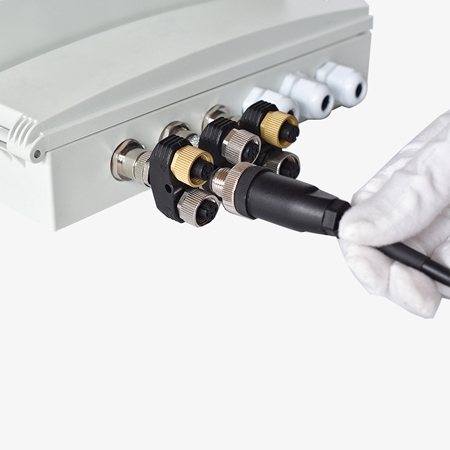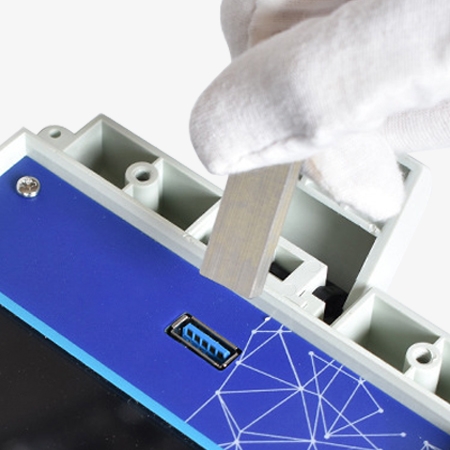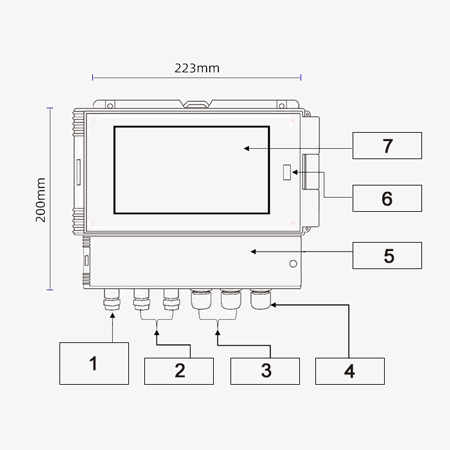The electrical conductivity tester adopts wall-mounted installation, which makes space utilization more full and reasonable. Real-time operating system, GUI graphical operation interface, customized personalized display.

Full-Featured
- The real-time operating system, paired with a 32-bit MCU, provides more timely response, can identify and control sensors, and conduct sensor testing, calibration, temperature adjustment, etc.
- Supports company-internal IoT and customized IoT.
- Hysteresis can be set arbitrarily to avoid frequent switching of relays.

Easy to Operate
- High-definition touch-sensitive color screen can display multiple parameters at the same time.
- Self-set data storage cycle can view historical data, is easy to export.
- IP65 waterproof and moisture-proof casing, surface spray-painted layer.
Applications
sisco conductivity meter, an intelligent online chemical analyzer, is widely applied for continuous monitoring and measurement of EC value or TDS value or ER value and temperature in the solution in the industry of thermal power, chemical fertilizer, environmental protection, metallurgy, pharmacy, biochemistry, food and water, etc.

| Model | SISCO-CDTYM-DDL985 | ||||
| Conductivity | Range | 0~20.00μS·cm-1 | 0~200.0μS·cm-1 | 0~2000μS·cm-1 | 0~20.00mS·cm-1 |
| Electrode | 0.01 | 0.1 | 1.0 | 10.0 | |
| TDS | Range | 0~10ppm | 0~100ppm | 0~1000ppm | 0~10000ppm |
| Electrode | 0.01 | 0.1 | 1.0 | 10.0 | |
| Salinity | Range | 0~300% | |||
| Resolution | 0.1 | ||||
| PH Range | 0~14pH | ||||
| Automatic Temperature Compensation | 0~100℃ | ||||
| Accuracy | 2.0 %(FS) | ||||
| Current Output | 4~20mA | ||||
| Output Load | <750Ω(4~20mA) | ||||
| Operating Voltage | 220V AC ±10%, 50/60Hz | ||||
| Display Resolution | 800×480 | ||||
| Operating Temperature | 0~60℃ | ||||
| Relative Humidity | ≤90% | ||||
| Protection Level | IP65 | ||||
| Host Dimension | 96mm×96mm×168mm | ||||
| Host Weight | 1.51kg | ||||
Structure Diagram

- Test/Communication Interface
- Communication Interface
- Output Interface
- Power Interface
- Wiring Compartment
- USB Interface
- Display Screen
Q1: What is a conductivity meter?
The conductivity meter is mainly an instrument for measuring the current capacity of the liquid medium. They are generally used for continuous monitoring of conductivity values in electric power, the chemical industry, metallurgy, environmental protection, pharmaceuticals, fields, lakes, scientific research, food and tap water, as well as in water treatment and aquaculture experiments.
Q2: How does a conductivity meter work?
Conductivity Meter Principle Conductivity is a numerical representation of the ability of a solution to conduct electrical current. The conductivity of water has a certain relationship with the number of inorganic acids, alkalis and salts contained in the water. When their concentrations are low, the conductivity increases with the increase of the concentration. Therefore, this indicator is often used to infer the total concentration or salinity of ions in water. Conductance (G) is the inverse of resistance (R). As a result, when two electrodes (usually platinum or platinum black) are inserted into the solution, the resistance R between the two electrodes can be measured. According to Ohm's law, the resistance value is proportional to the electrode spacing L (cm) and inversely proportional to the electrode's cross-sectional area a (cm2 ).
Q3: What is a conductivity meter used for?
- Water quality monitoring: The conductivity is affected by salt, inorganic acid, alkali, etc. in the water, so the higher the conductivity, the higher the concentration in the water will be reflected, the total concentration and salt content of ions in the water can be understood, and the purity of the water quality and due to the control of the production process, the conductivity of the water will vary with the TDS content in the water.
- Electroplating solution: Conductivity is an important parameter reflecting the electroplating solution. It can reduce the voltage in the electroplating bath and improve the dispersion ability of the electroplating solution. The conductivity of the electroplating solution can be reflected by measuring the conductivity.
- Atmospheric monitoring: The conductivity meter is used in atmospheric monitoring mainly for pollutants contained in the atmosphere such as carbon monoxide, sulfur dioxide, carbon dioxide and various nitrogen oxides. It can pass the gas absorption device and pass the gas through the absorption liquid to check the change of conductivity and monitor exceeding the standard in the polluted area
Tips: Conductivity Meter Calibration
Calibration of the conductivity meter is an important step to ensure that its measurement results are accurate and reliable. Before calibrating the conductivity meter, you need to prepare a series of standard solutions with known conductivity values. Make sure that the conductivity meter's electrodes and sensors are clean and undamaged, and that the battery is fully charged or the power connection is normal. In addition, check whether the electrode connection wire is normal, ensure that the electrode and the sensor are in good contact, and avoid the influence of bubbles and dirt. Then enter the calibration mode according to the instructions in the operating manual. You can choose conductivity or TDS calibration, or perform conductivity/TDS calibration in USER mode according to the different modes of the instrument. After the preparations are done, you can calibrate. Immerse the conductivity meter's electrodes in the standard solution, wait for the instrument to stabilize, and record the readings. You can use standard solutions with different conductivity values for multi-point calibration to ensure that the instrument can measure accurately in all ranges. After the calibration is completed, use the verification standard solution to check to ensure the accuracy of the readings. Compare the readings of the conductivity meter with the actual conductivity values of the standard solution to determine whether the calibration results are qualified. If the error is found to be beyond the allowable range, recalibration or maintenance may be required.
Thank you for buying industrial test and measurement equipment on SISCO.com, all products sold by SISCO and the partner cover a 12 months warranty, effective from the date of receiving the products.
What is covered?
SISCO is responsible for providing free spare parts, and free technical support to assist the customer to repair the defective products until the problem is solved.
What is not covered?
- Product purchased from anyone other than a SISCO store or a SISCO authorized reseller.
- Expendable parts.
- Routine cleaning or normal cosmetic and mechanical wear.
- Damage from misuse, abuse or neglect.
- Damage from use of parts other than SISCO approved.
- Damage from use outside the product’s usage or storage parameters.
- Damage from use of parts not sold by SISCO.
- Damage from modification or incorporation into other products.
- Damage from repair or replacement of warranted parts by a service provider other than a SISCO authorized service provider.
- Damage caused by the application environment not meeting the product usage requirements and the failure to perform preventive maintenance.

